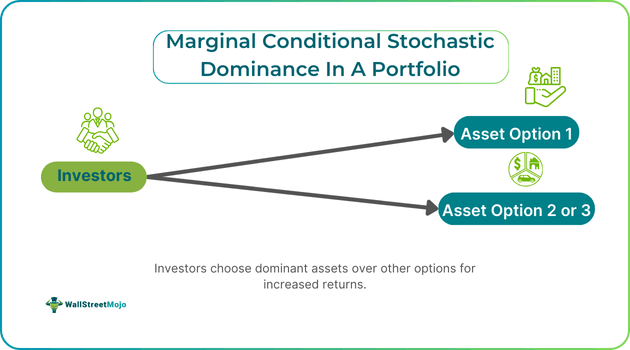Table of Contents
What Is Marginal Conditional Stochastic Dominance?
The Marginal Conditional Stochastic Dominance (MCSD) concept states that risk-averse individuals prefer to increase one risky asset's share over another when presented with a particular portfolio. This concept expresses the conditions under which investors make such preferences. It was introduced by Yitzhaki and Olkin in 1991.

Compared to SSD (second-degree stochastic dominance), marginal conditional stochastic dominance is a less challenging concept better suited to empirical study. This is because it considers slight variations in holding riskier assets in a certain portfolio. The concept helps detect inefficiency and improve inefficient portfolios. Marginal conditional stochastic dominance has also been used to solve issues in asset allocation.
Key Takeaways
- The Marginal Conditional Stochastic Dominance (MCSD) concept states that risk-averse individuals prefer to increase the share of one risky asset over another when presented with a particular portfolio.
- It is considered an extension of Arrow's theorem. MCSD helps identify favorable gambles by incorporating investors with random wealth or portfolios with random returns.
- The MSCD is considered an extension of second-degree stochastic dominance, and it can rank securities in accordance with the marginal changes in the return distributions.
Marginal Conditional Stochastic Dominance Explained
Marginal conditional stochastic dominance (MCSD) is a concept that states possible conditions under which risk-averse individuals could prefer increasing the share of a risky asset over another. The method helps analyze an individual's portfolio of risky assets. It tells if the investor can invest in a new asset in the background of having a risky portfolio. To conclude, MCSD gives the conditions or recommendations under which that individual has to include that new asset in the portfolio by either reducing, at a margin, the existing asset's share.
MCSD can help evaluate the superiority or dominance of an asset option over another. Here, dominance indicates all risk-averse investors' utility that can be enhanced by increasing the shares of a dominant asset at the cost of the asset dominated. It means that the investors' portfolio performance can be improved by raising the share of dominant assets and decreasing the share of others.
Hence, they are used to build optimal portfolios. MCSD is considered an extension of Arrow's theorem. The theorem states that a risk-averse individual may not always participate in an unfavorable gamble or one that is barely fair but always participates in a favorable one. MCSD helps identify favorable gambles by including investors with random wealth or portfolios with random returns, among other criteria.
Examples
Example #1 - A Hypothetical Example
Let us consider a hypothetical example of an investor using marginal conditional stochastic dominance (MCSD) to make an investment decision. Suppose Dan is an investor, and in his portfolio, he has three asset options (A, B, and C) and wants to know which provides the highest return for the prevailing market conditions. He determines whether the asset of option A dominates B or C in a bull market condition and repeats the same in a bear market condition with the available past data on the asset performance. After analyzing, Dan finds out that A dominates both B and C in terms of returns, which exhibits MCSD over other options. Since A has been chosen, a larger proportion of his portfolio will be allocated to asset A by reducing his shares in assets B and C.
Example #2 - A Real-Life Example
A study was conducted titled The Role of Diversification Opportunities in International Equity Flows: A Comparative Analysis of Developed and Emerging Markets. It examines the impact of diversification opportunities on international equity flows. The analysis utilizes the concept of marginal conditional stochastic dominance (MCSD) to estimate the diversification potential offered by different return distributions.
It was assumed that the investors were risk-averse, and the study provided strong evidence that diversification opportunities determined international equity flows. The study also revealed that dominant distributions influenced these opportunities. It focused on the dominant distributions and revealed a propensity toward efficiency in that MCSD-dominant markets draw flows while MCSD-dominated markets tend to lose flows.
Applications
MCSD can be used to estimate diversification opportunities, especially in determining equity flows in international markets. Studies were conducted to compare individual markets to a global market portfolio. In them, the market portfolio dominates specific security. If shares of all securities in the portfolio are increased and the dominant security is reduced, it improves all risk-averse investors' portfolios. Thus, it helps test whether a market or a global portfolio dominates it. It also evaluates the response of the fund flow in the market.
The MSCD is considered an extension of second-degree stochastic dominance. It can rank securities in accordance with the marginal changes in the return distributions by attributing them conditionally to the market proxy distribution. This technique serves as an effective method for measuring portfolio performance without specifying the return-generating process.
